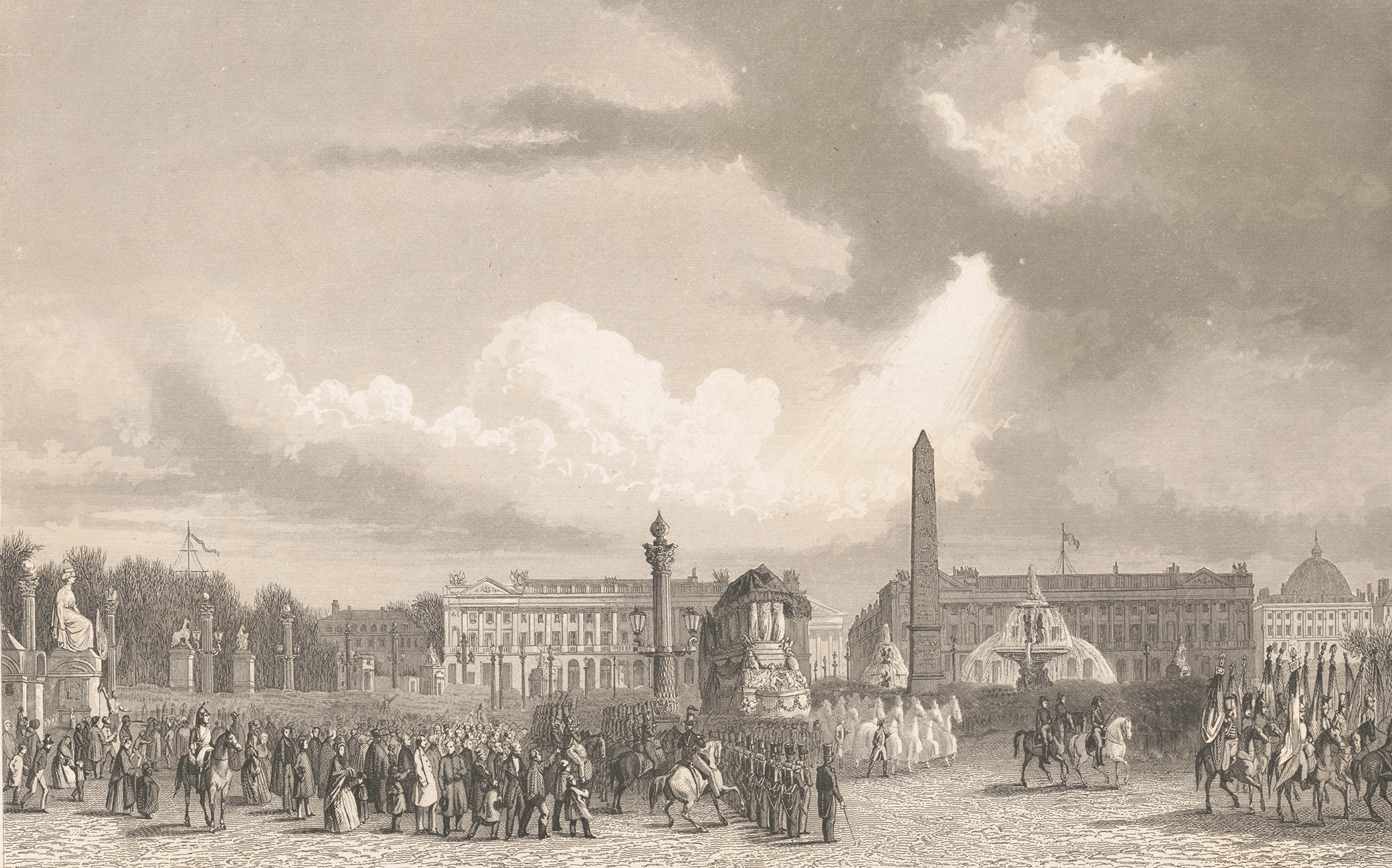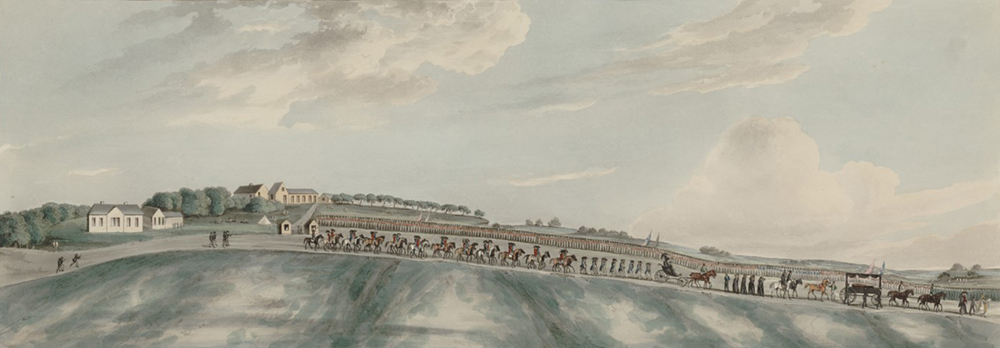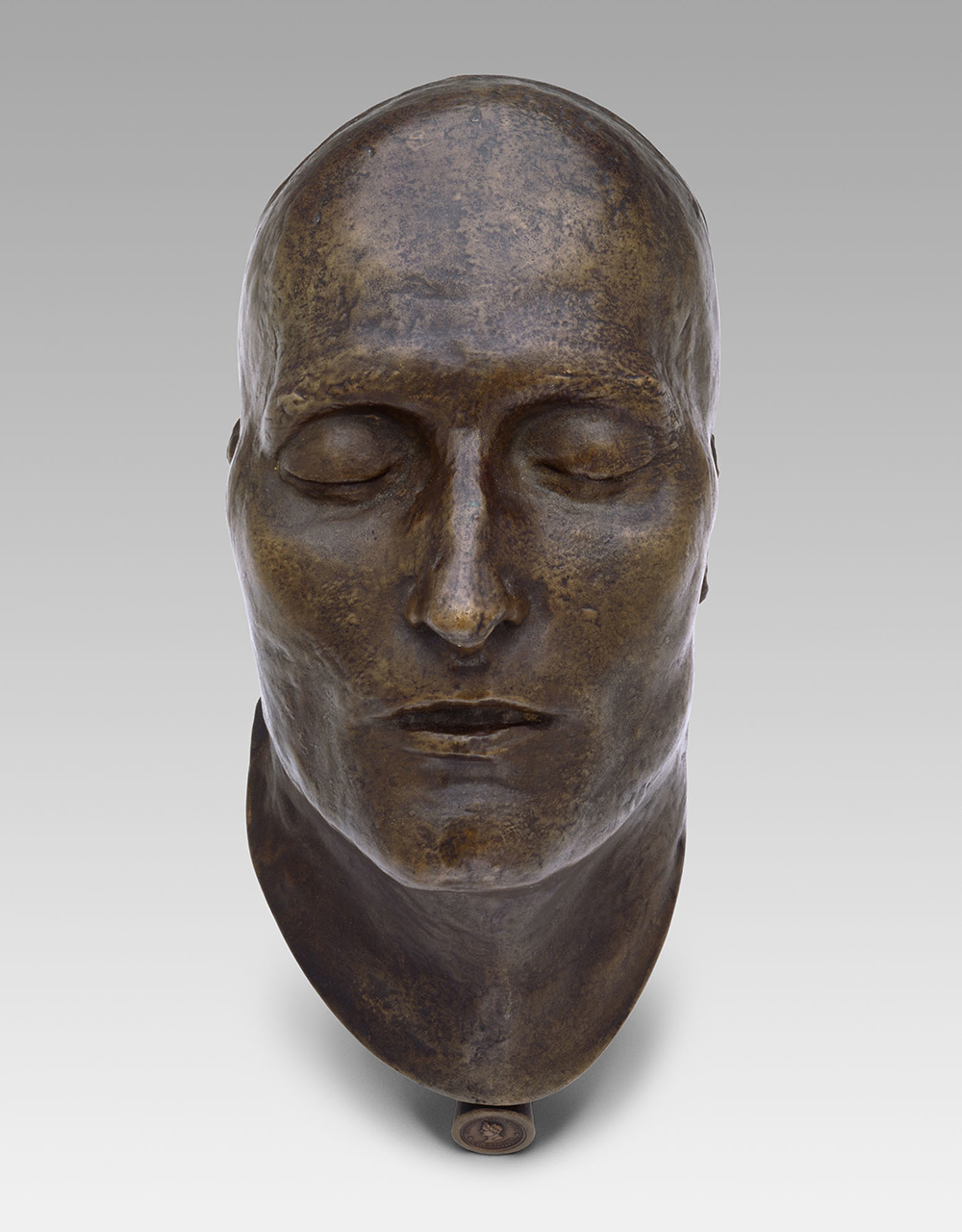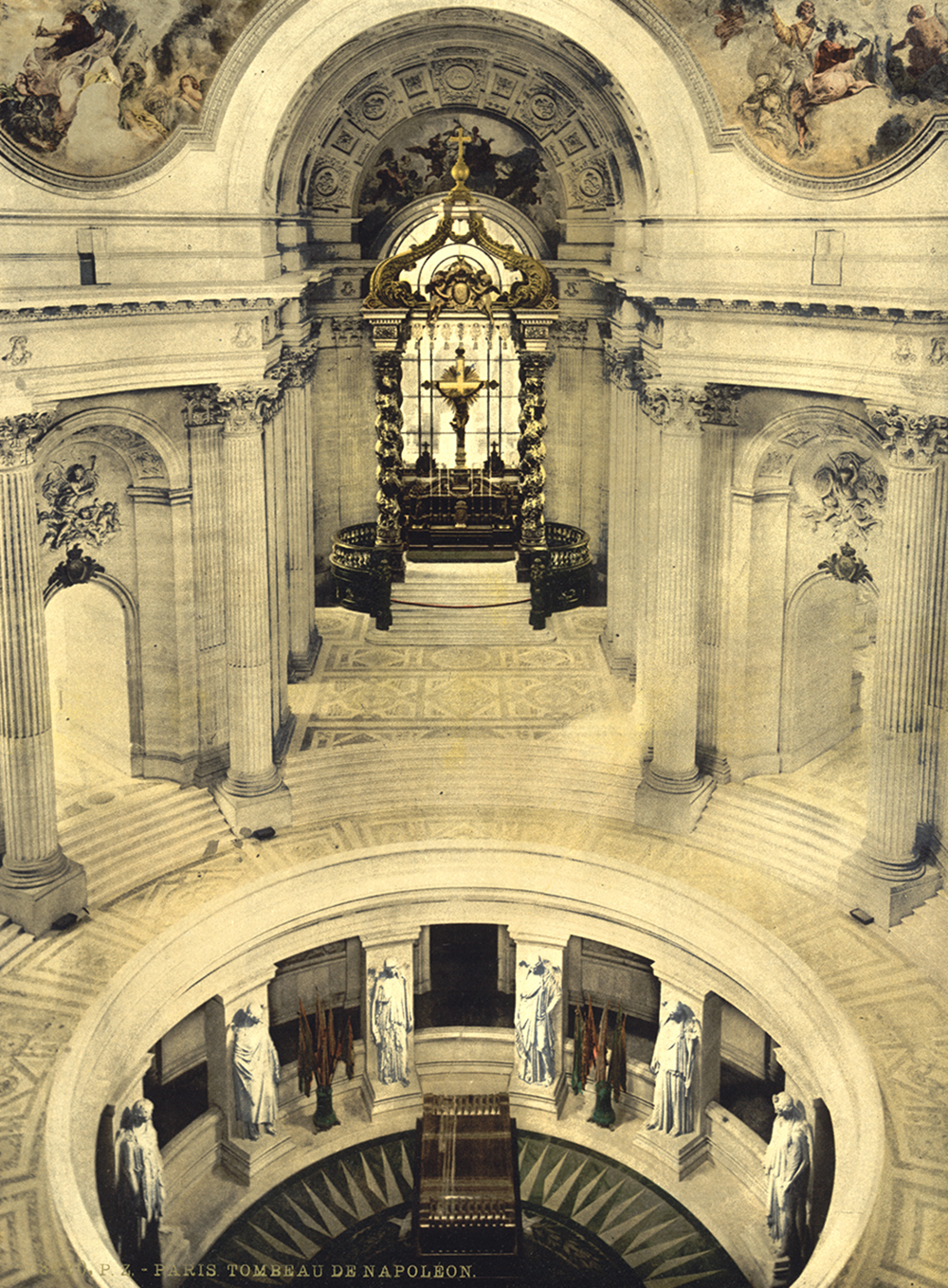
An engraving of the funeral procession for the remains of Napoleon by Edouard-Henri Girardet, 1840. Library of Congress, Prints and Photographs Division.
Obviously, Napoleon Bonaparte was not involved in organizing his own funeral, which took place more than twenty years after his death, but in the end the ceremonial turned out to be worthy of the personage. In it we find the mixture of incomparable grandeur and kitsch that gave its style to his period. All that Egyptian, Roman, and Carolingian bric-a-brac made up an “Empire” style that did not survive its inspirer and has not always aged well. However, Napoleon believed it was necessary to lend his very new royalty a little patina. No doubt his victories did more for his renown than the pompous settings with which he decorated his power, but there was something touching about this bad taste redolent of the parvenu. It “humanized” Napoleon; it reduced a little, very little, this gigantic, extraordinary, incomparable personage to the level of common mortals.
It was in 1830 that Victor Hugo composed the famous verse: “Oh, don’t worry! We’ll give you a fine funeral!” To tell the truth, the emperor’s loyal followers had not waited for Hugo to be converted to their cause to demand the return of their hero’s remains. As early as July 14, 1821—only two months after Napoleon’s death on Saint Helena—General Gourgaud, one of his companions in exile, presented the chamber with a petition along these lines. We can imagine that Louis XVIII and then Charles X were not exactly eager to see the awkward body return among the French.

If the restored Bourbons refused to have anything to do with the Revolution and the empire, that did not prevent either the cult of the republic or the Napoleonic legend from surviving and rapidly expanding. Ever since the emperor’s death on Saint Helena in 1821 and the publication of Emmanuel-Auguste-Dieudonné Las Cases’ Memorial in 1823, Napoleon was everywhere, in books and songs, in engravings and on plates, in the form of statuettes, busts, pipes, and tapestries. The time when the “dark legend” held sway, after the first abdication in 1814 and again shortly after the Hundred Days, was already far in the past. Napoleon, whose legend had faded after the disastrous Russia campaign, was looking better. He was no longer the despot of 1810 or 1811, but the heir and guarantor of the Revolution, the Petit Tondu (“little short-haired fellow”) who was close to his soldiers and attentive to the condition of the humble: the “Napoleon of the people.”
Petition after petition were being filed in vain when the revolution of 1830 broke out. Louis-Philippe, who owed his throne to the July uprising, was no more fond of the emperor than he was of the Bourbons of the elder branch whom he was succeeding. He had always thought that Napoleon had stolen his destiny in 1799, at the time when the collapse of the Directory and a further invasion opened the door to a restoration of the monarchy of which he might have been the beneficiary. Didn’t the Duke of Orléans belong to the royal family, even if he had proved, before 1793, his attachment to the Revolution’s liberal ideas? Who was more capable than he of incarnating the alliance of monarchy with liberty under the aegis of the Constitution to which the men of 1789 had aspired in vain? But then the Corsican had overtaken him, depriving him of his role and dooming him, perhaps, to an endless exile. He had to wait for thirty years, during which time Napoleon, Louis XVIII, and Charles X succeeded one another. An interminable wait.

The year 1830 provided a happy conclusion to 1789. This liberal regime, a guarantor of peace abroad and order at home, presented itself as an outcome and an heir to both the former monarchy and the Revolution. Charles de Rémusat, the minister of the Interior, summed it up when he proposed to the Chamber that Napoleon’s body be brought back to France, since “the monarchy of 1830 is…the sole and legitimate heir to all the sovereigns in whom France takes pride.”
Although the July Monarchy was at first presented as the heir and guarantor of 1789, less the saga, it retained no more than a few weeks the popular character that the revolutionary circumstances of its birth had conferred on it. Six months later, the divorce was consummated and a ferocious repression was about to befall all those who sought to overthrow this new monarchy that had, according to them, betrayed the promises made during the “Three Glorious Days” (July 27, 28, and 29, 1830) of the revolution. For Louis-Philippe, making a few concessions to the left and thus putting the great memories on his side was not a bad policy—or at least he hoped so. The statue of Napoleon was returned to its place atop the column in the Place Vendôme, and work to complete the Arc de Triomphe de l’Étoile was resumed. But returning the emperor’s body to France was out of the question. As under the reign of Louis XVIII, multiple petitions were filed in vain. The government paid them no attention. Perhaps the emperor would have reposed still longer on Saint Helena had Adolphe Thiers, the prime minister, not been requested to form a new government in March 1840.
It has been said that Thiers made himself the proponent of returning Napoleon’s remains because he saw in this good publicity for the Histoire du Consulat et de l’Empire on which he was working and whose first volume would appear five years later. That is not impossible, even if Thiers did not need Napoleon to become a fashionable author: his Histoire de la Révolution française (1823–27) had established him as the leader of all those who were working to rehabilitate 1789 and even 1792. Thiers sincerely admired Napoleon. While working on his great study, he had grown fond of his hero, always trying to weigh the pros and cons, to clearly distinguish the responsibilities that, he showed, were not always on the side of “the Ogre.” Bringing back Napoleon’s remains was, of course, a political coup of which he expected to derive the benefit, but it was also an homage paid to the hero by the French Revolution’s heirs.
Louis-Philippe did not put up much of a fight. Thiers had warned him: Irish patriots were getting ready to demand that the British government hand over Napoleon’s body to France, and it would be better for him to take the initiative. On May 1 Louis-Philippe notified his minister that once London’s consent had been obtained, one of his sons, the Prince of Joinville, would sail to Saint Helena. After all, the king no longer thought that the specter of Napoleon could represent a political danger. He had defeated conspirators of all kinds, legitimists or republicans, who had tried to overthrow him, as he had the workers’ insurrections that had marked the beginnings of his reign. The Napoleonic legend was alive more than ever, but it was only a legend, not a political force or the standard of a party. “Sooner or later,” the king told his friends, the return of Napoleon’s ashes “would have been forced by petitions. I prefer to grant it. There is no danger. The [Bonaparte] family is of no importance.” In London, the French ambassador easily obtained the British cabinet’s consent: “What do these old bones matter to England?”

When, seven months later, the frigate La Belle Poule returned to France with the emperor’s coffin on board, Thiers had been dismissed from government and replaced by François Guizot, another historian, who had previously served as minister of education and ambassador to London. As a result, the ceremony lost its political interest, especially since the new head of government was not as confident as the king and saw many disadvantages in this funeral, which would not be very flattering for the July monarchy; the people, far from being grateful to the king for having brought the hero’s body back to France, would judge all the more harshly the narrowly bourgeois and prosaic character of the regime. Guizot did all he could to diminish the impact of the ceremony, preventing the government from taking part. The parade would be purely military: the emperor was a soldier returning to be with his men, received by army veterans and buried in a site dedicated to France’s military glories.
The preparations had fallen far behind schedule. Activity increased as Napoleon’s body was being carried up the Seine. When the vessel transporting the coffin tied up at Courbevoie, in Paris’ suburbs, on December 14, 1840, the setting was barely finished. However, the next day, despite glacial cold and falling snowflakes, an immense crowd gathered along the route taken by the convoy, from the Pont de Neuilly to the Arc de Triomphe, then down the Champs-Elysées to the courtyard of Les Invalides. Victor Hugo put it nicely when he said that it was as if the population of Paris had flowed to one side of the city, “like a liquid in a tilted vessel.” In the eastern part of Paris, the streets were empty, and Hugo heard his steps ring on the frozen pavement. A few people ran past him, all of them hurrying toward the west, and then he noticed a vague rumbling that increased when he crossed the Seine and, following the left bank, approached the esplanade of Les Invalides. The crowd was enormous.

The cortege was moving slowly through the crowds and between two ranks formed of eighty thousand soldiers and national guardsmen drawn up from the Arc de Triomphe to Les Invalides. Cheers were heard, and songs to the glory of the Petit Tondu, and a few people sang the “Marseillaise.” However, Victor Hugo states that disappointment competed with emotion. It has to be admitted that the setting was not up to the level of the event. The heroic figures arranged along the route were made of plaster, the paintings on canvas looked like “cast-offs and rags.” The great men hastily painted on large canvases installed on the esplanade of Les Invalides, who were supposed to provide a cortege for the hero as he entered his last resting place, cut a sad figure. Here and there, the paint, too fresh, had run. The plaster could be seen beneath the false marble, and the pasteboard beneath the stone. “The petty clothed the grandiose,” Hugo said. Nonetheless, the catafalque, drawn by sixteen horses caparisoned in gold, had a certain style, but it also had a major defect: the emperor’s coffin was invisible.
A cobbled-together procession would have been a failure had it not been for the presence, even if invisible, of an immense memory, so great that the efforts made to appropriate it, to tame or neutralize it, seemed even pettier and meaner than they really were. William Thackeray found the ceremony imposing not because of its grandiose character—he, too, mocked the unsuccessful setting and the government’s obvious ill will—but because of the people’s fervor: as the boat carrying Napoleon’s remains made its way up the Seine, the banks of the river “were lined with old soldiers and country folk who had come from miles around to contemplate Napoleon’s coffin and to pray for him.” The same fervor was found in Paris, even though the bitter cold dispersed the crowd as soon as the procession was over. The streets emptied out as they had filled up, and nothing remained of this day apart from the plaster statues, the banners, and the bleachers in the courtyard of Les Invalides, which workers were hastening to remove. A few weeks later, the coffin was placed in one of the six chapels in the church, the one dedicated to Saint Jerome, where it remained until 1861. In the meantime, another Napoleon, the third of the name, had reestablished the imperial throne, and it was he who, on April 2, presided over the installation of the coffin in the red porphyry sarcophagus, at the center of the open crypt. Forty years after his death, Napoleon came home for good.
Excerpt adapted from Napoleon and de Gaulle: Heroes and History by Patrice Gueniffey, published by Harvard University Press. Copyright © 2020 by the President and Fellows of Harvard College. Used by permission. All rights reserved.
